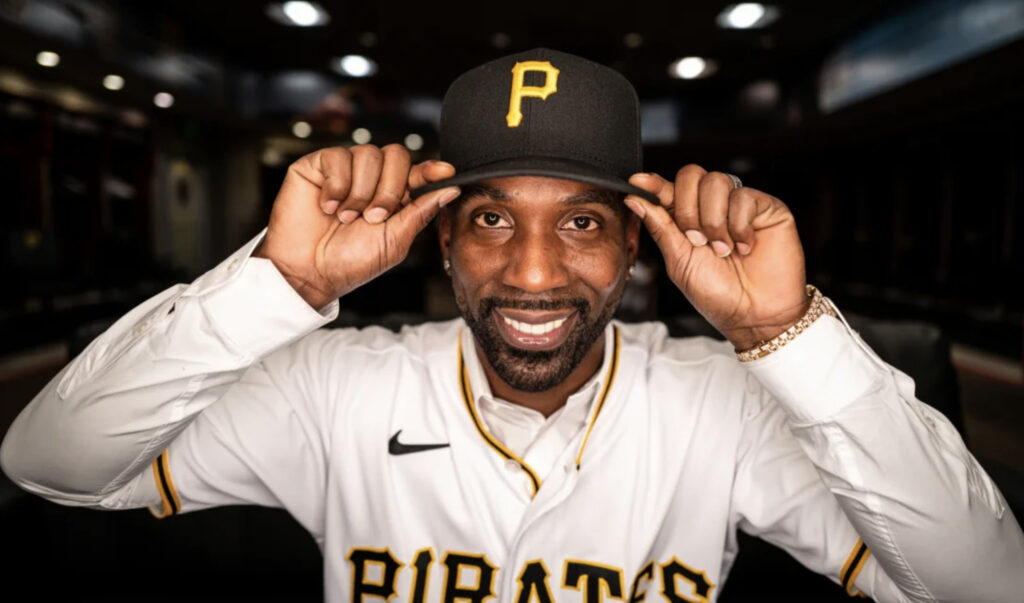Before we even get started here, I have an admission. Writing this feature is something I went back and forth on for the better part of a week. Player comparisons are fun as hell, and for the general public especially, they represent an exercise in visualization. It can often be difficult to imagine what a player is going to be or how they are going to perform at the next level. After all, college players taken in most drafts won’t reach the big leagues for two-or-more years after draft day. For that reason, I wanted to write an article based on data and scouting that should help readers imagine what some of their favorite college hitters might look like three or four years from now.
Key word? MIGHT.
While player comparisons are fun and exciting, they are nothing more than an exercise. Provided the information and data points we have today, these are rough guess-timations. Every player develops differently. Their bodies change. Their approaches change. Hell, their tools change altogether. So while these are essentially “what they look and play like” right now, I am not beholden to these words and they are for your entertainment only.
Thank you for coming to my TED talk.
The following players comps were put together through the use of a number of different parameters. Body projection, athleticism and movement patterns were all taken into consideration. And you’ll see a lot of that in this feature. But data points and how players play the game were equally weighed to get a feel for future predictive production.
Enjoy.
Dylan Crews, OF — LSU
FSS PLUS Rank: 1
Pillars: Extremely low chase rates, Efficient launch angle dispersion, Short path to the ball. Athleticism.
Comp: Andrew McCutchen
Crews is a premium prospect with a premium comparison. At this late-stage in McCutchen’s career, he’s a borderline hall of fame player with close to 52 fWAR over 15 seasons. Here are some similarities:
- Since his debut, McCutchen has had one of the keenest eyes of any outfielder in the game featuring low chase rates year in and year out, including five seasons with a chase rate south of 22 percent.
- In 2015, at his peak, McCutchen ranked among the Top 10 hitters in baseball in Sweet Spot%. Crews is a barrels and launch angle machine.
- Both are roughly 6-0, 200 lbs
- McCutchen began his career as a solid centerfielder with plus speed. Crews will likely do the same, although he’s more of an above average runner. McCutchen also likely used his legs on the bases more than Crews will.
- McCutchen never had double-plus power, and neither does Crews. But because of their bat path and patient nature, they take mistakes and do damage. At his peak, McCutchen was a guy who posted a ton of .280/.380/.480 campaigns with roughly 25-28 homers per year. That’s about the expectation for Crews.
Wyatt Langford, OF — Florida
FSS PLUS Rank: 2
Pillars: 70-grade raw power, patience, vicious attack angle and bat speed, foot speed
Comp: George Springer
Another premium comparison, Langford doesn’t have the same 6-foot-3-inch frame that George Springer does, but their play style should end up similar both in terms of capabilities on the field and production on the back of a baseball card. Over ten seasons, Springer has been worth about 33 fWAR, leveraged by 228 career homers.
- Springer has always been a patient hitter at the plate ranking inside the 80th percentile for chase rate since 2017. He’s also routinely in the upper-third for walk-rate.
- The game power is considerable. Springer topped out at 39 HR in 2019, but has averaged close to 30 homers per year in seasons he’s played at least 122 games.
- Some style similarities in the stride ambush nature when the situation calls for it.
- At his peak, Springer floated on the fringes between a plus and double-plus runner. That’s where Langford fits.
- Springer probably has a tick better arm, though both players are physically capable of handling all three outfield spots.
- Langford projects to have a tick better bat-to-ball skills than what Springer has shown thus far.
- Early-career Tommy Pham is a really solid comparison for Langford as well, and probably a more fitting comp. That said, his flash was short-lived and Langford should have more longevity.
Jacob Gonzalez, SS — Ole Miss
FSS PLUS Rank: 8
Pillars: Extremely high contact rates. Open hips. Bigger body for the position. Solid power projection.
Comp: Carlos Guillen
Gonzalez is a very tough player to compare anyone to as his movement patterns and play style are unique. He deploys a wide-open stance and throws his hips before his shoulders. Gonzalez avoids “stepping in the bucket”, but his unconventional operation lives on its own. This is likely a fringy defensive shortstop who will make his money in his career with the bat. A la, Guillen.
- This was a tough one, and it was built more on style than production.
- Guillen’s career featured a wide-open stance from the left side with quick hips and pull-side power. He was a switch-hitter, but his impact was from the left side.
- He was an above average hitter who used the whole field.
- Guillen was never a showstopper on defense, but he was solid. Gonzalez probably a bit fringier at the position, but some similarities.
- Guillen was listed at 6-foot-1, 205-pounds during his peak, Gonzalez is currently listed at 6-foot-2, 205-pounds. He’ll likely end up playing a bit bigger than Guillen, and may be moved to third base.
- Both were purely average runners and stolen bases were never a huge part of their game, except for a year or two in Detroit toward the back-half of Guillen’s career.
- Guillen was a career 111 wRC+ guy, and a 115-120 wRC+ bat in his prime. That’s about where one could see Gonzalez. A 20 homer per year type of guy with low strikeouts and lots of double at his peak.
Upper deck two-run home run by Carlos Guillen gives the @mariners a 4-0 lead in Game 6 of the 2000 ALCS!#MarinersClassics | #ROOTSPORTSClassics pic.twitter.com/nXsvytrGqF
— ROOT SPORTS™ | NW (@ROOTSPORTS_NW) April 24, 2020
Jacob Wilson, SS — Grand Canyon
FSS PLUS Rank: 9
Pillars: ELITE bat-to-ball skills. Long frame. Bloodlines. Potential for budding power.
Comp: Nico Hoerner
This isn’t a great comparison as Wilson has three inches on Hoerner and does have the potential to grow into a bit more power than what Hoerner has shown thus far. It may be a bit of a limited ceiling, but the floor and the impact that can be made at the top of a lineup here has value.
- Hoerner one of baseball’s best contact hitters.
- Defensively, Hoerner has shown well at shortstop, but better bouncing around infield. Advocates of Wilson believe in the shortstop, but he may ultimately bounce around the dirt a bit in his career as well.
- Power has been slow-developing for Hoerner in his career. Peaked at 10 homers in 2022. 16 career. The consensus does not expect Wilson to be a power hitter.
- Hoerner has posted extremely low strikeout rates for the era. Wilson should be more of the same.
- Hoerner is a league-average offensive contributor, but an 80-grade leader in the clubhouse. Wilson is revered for his clubhouse manner.
- Wilson presents more projection in the frame, but Hoerner’s output is the likeliest outcome for a player like Wilson.
Kyle Teel, C — Virginia
FSS PLUS Rank: 11
Pillars: Fantastic in-zone bat-to-ball, huge athleticism behind the plate, above average runner, considerable raw power, left-handed hitting catcher
Comp: B.J. Surhoff
Finding an athletic left-handed hitting catcher with some of the traits that Teel possesses is next to impossible. From the right side, guys like Russell Martin immediately come to mind, but Teel’s left-handedness is a legitimate asset. Surhoff was a foundational piece in Milwaukee in the late 80s, and an anchor behind the plate. He’d end up hitting for more power once he arrived to Baltimore, ultimately finishing his career with 188 homers.
- Both Teel and Surhoff are/were considered gritty as hell. Guys who left it all on the field.
- Like Teel, Surhoff was a fantastic athlete early in his career. He stole 141 career bases. Teel could rack up 100 if he chooses to run.
- Surhoff was a well-above average defender behind the plate early in his career.
- In the second-half of his career, Surhoff would peak in the power department, hitting 20-25 bombs per year.
- Teel will strikeout more than Surhoff, but Surhoff posted above average contact rates for his career.
- A perfect comparison in today’s game does not exist for Teel. Gregg Zaun is another reasonably solid comparison, as is Russell Martin, but the latter was right-handed.
Tommy Troy, 2B — Stanford
FSS PLUS Rank: 14
Pillars: Thick, strong body. Huge raw power. Underrated athleticism and speed. Short, quick to the ball with compact violence. Bat-first second baseman
Comp: Bret Boone
Bret Boone was a slugging second baseman during his days in Seattle. During his Mariners days, he routinely played in the 190- to 200-pound range on his 5-foot-10-inch frame. From 2000-2004, a five-year span, Boone averaged 28 homers and 10 stolen bases per year, running a .285/.343/.488 slash in the process. He was a bat-first second baseman who could be deployed in the middle of a lineup.
- Boone hit 252 home runs in his career and stole 94 bags. He was an above average-to-plus runner early in his career, something Troy should be able to replicate with his speed.
- Power-first second baseman with all-fields juice.
- Largely average at second base for his career with short, choppy steps. Reliable, not flashy.
- Both are thick, strong, sturdy-built frames with extremely quick hands and compact paths through the zone.
Enrique Bradfield Jr., OF — Vanderbilt
FSS PLUS Rank: 16
Pillars: Huge speed, fantastic glove, slasher swing, elite eye at the plate, lean frame, leadership qualities, sneaky power
Comp: Kenny Lofton
Kenny Lofton was one of the premier defenders and base-stealers of his generation. That pretty much what proponents of Bradfield see in the Vanderbilt centerfielder. They have extremely similar physical frames and Bradfield should end up emulating Lofton’s career play-style.
- Lofton stole 622 bags in his career, 70 at his single-season peak. Bradfield may be able to nab 50+ early in career.
- Both feature elite chase rates and elite contact rates. Lofton never struck out and was above average in terms of walks most years.
- Both have slasher mentality, keeping the barrel in the zone for an extended period, using the entire field well.
- Lofton peaked at 15 HR, that’s about what I’d forecast Bradfield to do. Like a guy who runs into 8-12 home runs per year in his best years.
- Lofton widely regarded as one of the best defenders in centerfield of his era. Bradfield should do the same.
Kenny Lofton – 10/15/2007
🍁 Postseason 🍁 pic.twitter.com/WRkM3c6NrS— Random Homers (@randomhomers) December 23, 2022
Matt Shaw, 2B — Maryland
FSS PLUS Rank: 18
Pillars: Elite exit velocities for his position, doesn’t chase, electric hands, fringy glove and arm, strong, stout frame
Comp: Brian Dozier
Matt Shaw has lightning quick hands and Dozier made a whole career out of turning around velocity in the strike zone. He was a power-hitting second baseman in an era where power didn’t come easily to that position. Shaw projects one of the more potent offensive threats at the position when he debuts.
- Dozier put some absolutely mammoth swings on pitches and ended up with 192 HR for a 2B
- Both are 5-11. Dozier ended career at 205. Shaw likely makes debut closer to 195
- Quick, compact hands through the zone
- Kept strikeouts awfully low for most of his career. Shaw should do the same.
- Dozier stole 105 bags in his career. Shaw has strong instincts and a good first step. Likely to be a base-stealer early in career.
- Dozier a tick above average with the glove. Shaw could be that at 2B.
Brock Wilken, 3B — Wake Forest
FSS PLUS Rank: 19
Pillars: Incredibly passive at the plate with hugely low chase rates. Mammoth raw power. Fly ball oriented. Huge frame, huge arm.
Comp: Rhys Hoskins
Hoskins has built an entire career on his passive approach and fly-ball approach. He’s a power-oriented first baseman who uses his large frame well to post huge exit velocity readings. He picks his spots carefully, much like Wilken.
- Hoskins has been one of the more patient, cerebral hitters in baseball since his debut with low chase rates and low swing rates.
- Wilken has more raw power than Hoskins, but both figure to be power-first corner infielders.
- Both have big, physical frames. Hoskins is 6-4, 245, Wilken will likely debut close to 6-4, 235.
- Wilken could play 3B, but there’s definitely a chance he moves across the diamond due to his physicality.
- Both are extreme fly-ball oriented hitters.
- Another solid comparison is CJ Cron, though Wilken possesses a more keen eye at the plate.
Chase Davis, OF — Arizona
FSS PLUS Rank: 21
Pillars: Huge pull-side power, sweet left-handed swing, big arm, corner profile, some contact concerns
Comp: Carlos Gonzalez
This may be the best comparison on this entire list, though it might ultimately end up being the most off the mark too. While Davis and Gonzalez look exactly the same in terms of the swing and the play style, Davis is more of a slugger. Still, this fruit hangs too low not to take.
- Gonzalez was a better runner than Davis.
- Gonzalez peaked at 40 HR in a single season and was always good for about 25 per year during his heyday.
- Davis has better arm than what Gonzalez had.
- Gonzalez was a high strikeout guy. Davis used to be a high-strikeout player until this year. He cut those numbers considerably in 2023. So that said, his career track record suggests swing and miss could still be a part of his game.
- Gonzales was an above average career hitter with three seasons over .300… Davis had a big year in 2023 and if he can repeat this output in pro ball, he has a chance to post some impressive slash lines in his career.
Carlos Gonzalez – 06/05/2016 pic.twitter.com/k2fVnJy1q1
— Random Homers (@randomhomers) May 25, 2023
Brayden Taylor, 3B — Texas Christian
FSS PLUS Rank: 24
Pillars: Extremely low chase, above average raw power, sweet swing, good runner/athlete
Comp: Chase Headley
Headley was a bit of a late bloomer, but came on strong as one of the Padres top prospects. His athleticism allowed him to play some outfield in the minor leagues, and Taylor could end up shifting around the field a bit too. Headley struggled to handle breaking balls in the strikezone early in his career, something Taylor is currently dealing with.
- Headley was a star at Tennessee and built a pro career off low chase rate and a sweet left-handed swing (he was a switch hitter).
- A good athlete early in his career, stealing 57 bags from 2009-2012. Taylor should run a bit more in pro ball.
- Headley peaked at 31 HR in 2012, but routinely hit 12-14 HR per year. Taylor should be a power-over-hit type of guy with low chase rates buoying his batting average and on-base numbers.
- In-zone contact rates were largely fringy to average most years for the Padres, though they improved later in his career.
- Another reasonably good comparison is Kyle Seager, who built a career on passivity at the plate and a grooved HR swing with a solid glove at third base.
Nolan Schanuel, 1B/OF — Florida Atlantic
FSS PLUS Rank: 30
Pillars: Patient hitter, extremely high walks, unorthodox stance, fantastic bat-to-ball, undervalued athleticism, Tall, rangy frame
Comp: Nathaniel Lowe
Lowe has been a revelation for the Rangers these past couple years. He’s a fantastic hitter who controls the zone beautifully and has very few flaws in his game at the plate. He uses the whole field, and is underrated as an athlete. He’s one of the better first basemen in baseball.
- Lowe has a tall, 6-foot-4-inch frame, 220-pound frame. Schanuel is similar.
- Lowe is among the league’s best in walk%.
- Lowe sprays the ball all over the field and lets the ball travel, much like Schanuel.
- A contact hitter by nature, Lowe has significant raw power. Much like Lowe. They can do both.
- Extremely patient hitter with extremely low chase rates
- Left-handed hitters.
- Lowe is one of the better foot-speed first basemen in the league, something Schanuel should be able to match.
Yohandy Morales, 3B — Miami
FSS PLUS Rank: 32
Pillars: Tons of chase, tons of bat speed, still limits strikeouts, incredible athleticism for his size
Comp: Nick Castellanos
Castellanos was a big-time third base prospect early in his career, and was a full-time player at the hot corner for four years with Detroit before getting traded and resuming his career in the outfield. He’s a big, long body whose athleticism is rare for a player of his size. Morales projects similar traits and a similar approach at the plate.
- Castellanos has always chased much, much higher than league average, but has limited his Ks. That’s been the book on Morales at Miami.
- Castellanos was an above average runner early in his career, and played third base at an average level. Morales might end up being a tick better defender than early-career Castellanos.
- While Castellanos is a poor defender in right field, but was mostly league average at third base in 2016 and 2017.
- Both have long, physical bodies with huge bat speed and impressive athleticism considering their size.
- Both players post enormous exit velocity numbers as their profiles are built around bat speed and game power.
Jack Hurley, OF — Virginia Tech
FSS PLUS Rank: 34
Pillars: Extremely aggressive at the plate. Explosive bat speed, Huge max exit velos. Wiry and rangy in the field.
Comp: Corey Dickerson
Dickerson is an explosive corner outfielder with solid foot-speed and big max exit velocity numbers. He’s an extremely aggressive hitter and made a name for himself pummeling mistakes. Dickerson came into the league with lean, projection strength and hasn’t really filled out too much.
- Dickerson is one of the most aggressive hitters of his generation with a swing percentage north of 56 percent. Hurley was one of the most aggressive hitters in college baseball last season with a swing percentage north of 50 percent.
- Both possess electric bat speed, Hurley a bit more-so. Despite Hurley’s size, he’s always ranked among the best in college baseball in exit velocity.
- Both post chase rates slightly below average.
- Neither player is ever in a hurry to draw a walk as both lag behind league averages for free passes.
- Extremely similar frame to Dickerson
- If you’re looking for another reasonably similar player, Tyler Naquin is a bigger body than Hurley, but possesses similar bat speed, aggression at the plate (54%), but considerably worse strikeout woes than Dickerson.
WSH @ KCR
May 27, 2023Corey Dickerson 1,000th Career Hits, it was a double pic.twitter.com/X8jrq0xtWi
— Nationals Homers (@Nats_HRs) May 27, 2023
Colton Ledbetter, OF — Mississippi State
FSS PLUS Rank: 39
Pillars: Low chase, huge max exit velocity, contact-quality concerns, above average runner, reasonably high contact, high walks
Comp: Lars Nootbaar
Nootbar isn’t a perfect comparison as he’s a bit more athletic and explosive than Ledbetter, but he’s made a career out of his ability to play every single outfield spot, picking his spots offensively to unleash his physical tools.
- Nootbaar has huge raw power, but struggles to get to it in games. Ledbetter is exactly the same.
- Contact quality has been an issue for both players.
- Nootbaar is an underrated athlete who can play all three outfield positions.
- Both are high walks players who take a passive approach to build their on-base percentages.
- Both have extremely low chase rates.
- Nootbaar has better arm strength and a better shot to handle centerfield.
- Ledbetter’s play style is a bit more similar to a player like Robbie Grossman, but he’s far more physical than Grossman. Either way, he projects to be a high on-base guy who has some highlight reel moments.
Brice Matthews, SS — Nebraska
FSS PLUS rank: 53
Pillars: Small frame, up-the-middle profile, electric hips and bat speed, low chase rates, high walks, stolen bases
Comp: Marcus Semien
Semien has a short, simple, compact swing that has done well for him throughout his career. He’s a player whose athleticism has really shown out in his offensive play, as well as on the dirt after really honing in his defensive fundamentals.
- Similar frame to Semien
- Similar batted-ball data to Semien
- Like Semien, Matthews could shift between shortstop and second base at next level.
- Both are plus runners who steal plenty of bases.
- Both have flatter bat paths but are excellent at creating loft.
- Both take their walks and consistently rank among the best in their league in free passes.
- Semien strikes quite a bit less than what Matthews has shown to this point in his career and is likely the better contact hitter than what Matthews will show.
- If we wanted to do style points, Matthews *looks* like Mookie Betts in how he carries himself, his swing, his follow-through and rangy style on the dirt.
- The Diamondbacks return for Josh Naylor… - July 25, 2025
- Five 2025 draft picks that could win Rookie of the Year in 2026 - July 21, 2025
- 2025 MLB Draft: The predictions you didn’t know you needed - July 16, 2025












